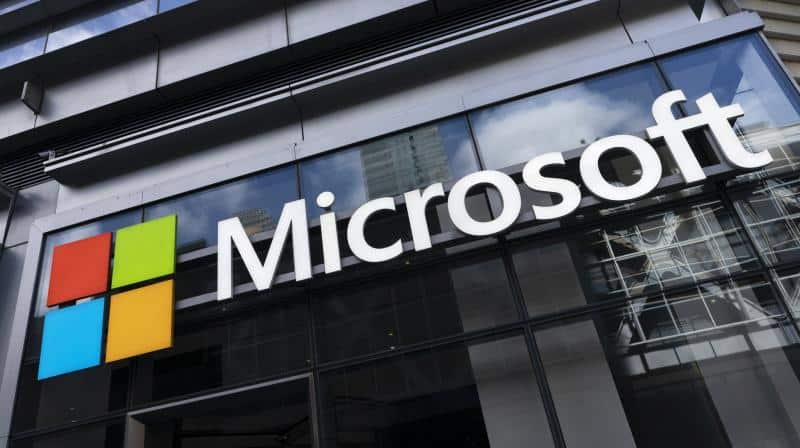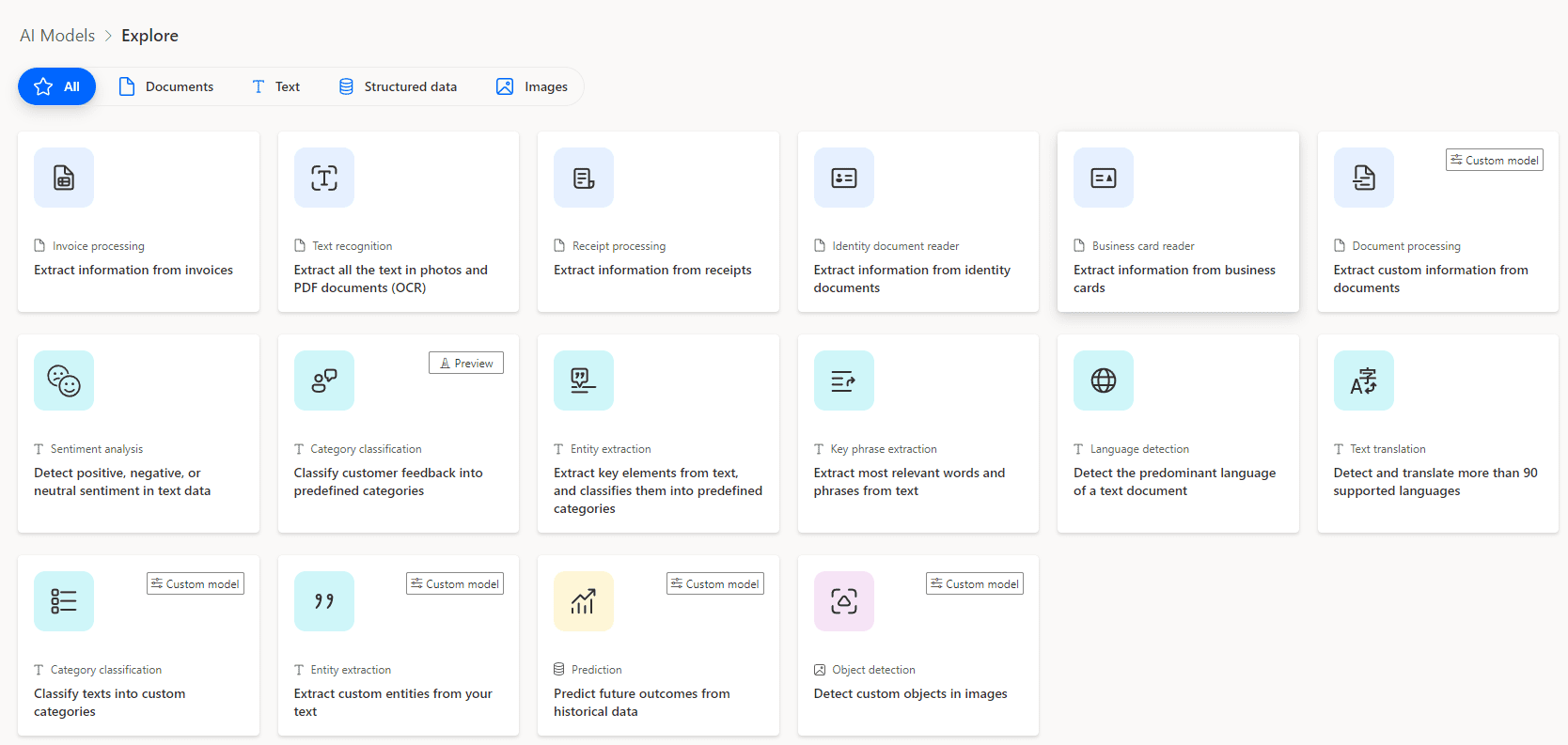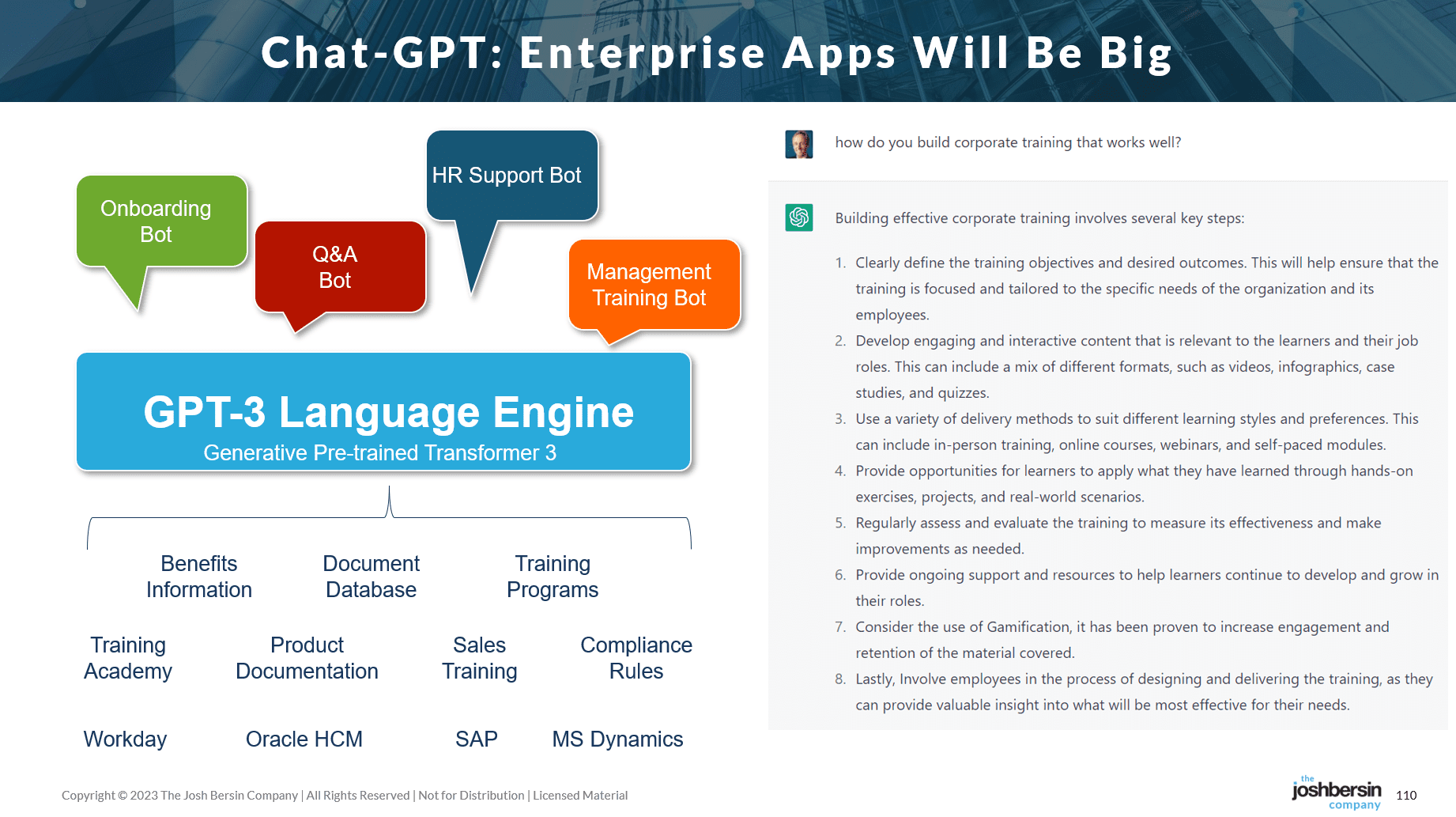Microsoft Launches ChatGPT For Dynamics Business Apps And The Enterprise. – JOSH BERSIN

While journalists worry about generative AI (chatbots and Large Language Models), Microsoft is powering ahead. This week the company took a big step and introduced OpenAI embedded into Microsoft Dynamics and also introduced development tools to let you build intelligent chatbots on your own data.
This opens the door on the biggest market of all: Generative AI used for enterprise apps and business productivity.
It’s important to realize that AI has many implementations. Many enterprise systems already use AI to identify fraud, pinpoint high profit customers, and identify patterns of growth, quality problems, and more. Amazon route scheduling and logistics is built on AI.
But the Generative AI (software used to create new content, including audio, code, images, text, simulations, and videos) which uses Large Language Models like ChatGPT from OpenAI, are different. They interpret language and images, index billions of words and phrases, and put together new content in a “human-like” way.
In business, where we are constantly reading, writing, and creating content, they can be enormously useful. So Microsoft is calling this new capability Co-Pilots: designed initially for Microsoft’s Dynamics business applications. (Following the name of Microsoft’s GitHub Co-Pilot for software developers.)
This begins the next “big step” in generative AI solutions: enterprise and business solutions. We can now use these fascinating tools in sales, marketing, supply chain management, finance, and much more.
OpenAI sees the opportunity as massive. Last week the company released its enterprise pricing and API, enabling any software developer or IT department to use these tools. So it’s natural that Microsoft, the company that prides itself on productivity tools, would immediately give us a toolset which is ready to use.
These announcements fall into three major areas:
First, embedding ChatGPT into sales, email, marketing, and customer service applications (Microsoft Dynamics) so business people can more quickly build websites, product pages, campaigns, sales messages, and customer service interactions. We all spend hours each day summarizing information, composing paragraphs, and trying to communicate, support, or sell to others. Much of this can be augmented with Microsoft’s Co-Pilots for Dynamics, making these enterprise apps far easier to use. These are branded “Co-Pilots.”
Second, Microsoft has linked ChatGPT to the company’s low code development system, Microsoft Power Platform. This system lets you build workflows (process automation) across many of the Microsoft applications and tools. So now you can “talk to your apps” and teach them to execute transactions for you. In the case of HR, imagine if you simply said to ChatGPT “please apply for 2 weeks leave starting in May and ask my manager for approval.” I guarantee that’s a lot easier than finding this transaction in an HR system.
Or for marketers, “Show me the customers who purchased more than 20% this month than one year ago and sort them by industry. Now send these customers a copy of the promotion we sent in November.” Get my drift? This is the bread and butter work that CRM, Sales automation, HR, and supply chain systems do. Once this toolset hits the market I bet Microsoft developers, partners, and integrators will build hundreds of “chat-enabled automations” for Microsoft systems.
Other examples (from Microsoft):
- A researcher can use the model to summarize text from weekly released reports and send it to their email, all with Power Automate. This helps inform their analysis and identify themes/trends at speed.
- A marketing manager can create targeted generated content ideas by entering specific keywords or topics and use the generated text for emails or social media posts, all within their Marketing team’s Power App
- A customer service agent can build a flow within Power Automate to summarize and classify and route customer queries for quick responses to complaints or feedback.
Third, Microsoft is launching tools to help you “build you own ChatGPT bot” from your corpus of corporate data. And to me, as an HR and leadership analyst, I see this as massive. Companies are sitting on terabytes of documentation, training, service, sales, compliance, and general HR information sitting in text, video, or audio form. All this can be indexed and “discovered” by ChatGTP, enabling any employee to ask a question and get an accurate, definitive answer. And unlike Bing which has to sort through marketing hype and all sorts of fake news on the internet, this is your reliable corporate data. So the quality should be very high.
This third set of tools feels massive to me. I cannot stop thinking about the hundreds of applications this will unleash.
Co-Pilots: ChatGPT Embedded In Dynamics Apps
Microsoft is one of the largest providers of SMB and mid-market business applications, including Dynamics 365 Sales and Viva Sales, Dynamics 365 Marketing and Customer Insights, Dynamics 365 Business Central, Dynamics 365 Customer Service, and the Microsoft Supply Chain Platform. The Dynamics business grew by 13% last quarter and some analysts believe it is close to a $6.5 Billion business. (Note: Workday’s revenues are around $5.1 Billion.)
Each of these applications uses various data entry, workflow, analytics, and process screens to configure, operate, and manage these business areas. If you’re a marketing manager, for example, and you want to upload a new product to your sales catalog, modify the website, input price and inventory information, and send out launch campaigns – you have a lot of work to do. These kinds of activities require in-depth understanding of the application and lots of quality control to get it all right.
The Co-Pilots can do a lot of this for you. The simplest example is Microsoft’s use of ChatGPT to help the user create a product overview, craft an email or blog entry, and develop a short and long product summary for your systems. This may save hours of editing and review. The second is to build the email campaigns, customer service responses, and other communications to market and sell this new product. And then when the customer has a problem and opens a case, the customer service agent can use ChatGPT to consolidate issues, write answers, and create ongoing communications.
ChatGPT Development Tools – Power Virtual Agents and AI Builder:
The new GPT in AI Builder and GPT in Power Builder Agents lets you build your own GPT Chatbots based on the information in your company! And this, to me, is one of the biggest markets of all. Imagine if you want to build a chatbot for customer service that reads through all your service and repair documentation to help people find repair tips. Or imagine if you build a GPT bot to scan your sales information to help prospects learn about your products.
Think, for example, about all the onboarding, employee experience solutions, leadership development, and other transition programs we build by hand in HR. If the Microsoft GPT bot works well, we can literally “point it” to these areas of content and then turn on the ChatBot for employees. The tools let you train and improve the dialogue over time, so you are now in the “ChatBot Development” business.
The Microsoft AI Builder, which has been available for some time, can already do many things. Now it can generate conversations from your own data. So you can use the models below and build custom AI applications that use the ChatGPT interface.
 |
As Microsoft states:
“Normally, when a chatbot encounters a question or response it hasn’t been trained on, it can only respond in one of two ways: ask the user to re-phrase or “fall back” to human agents, something we are all very likely familiar with. Now, using the power of GPT, you can connect your bot to your most current and useful data sources, like company websites or internal data and the bot can immediately start to use that data to construct a response. This means faster support for users through dynamic and relevant answers – all without authoring a single topic or spending additional development cycles – and makes bots useful straight out of the box within minutes.”
Think about how many internal data sources you can use here. Every corpus of benefits, onboarding, process, compliance, or training information can be indexed and “enabled” by ChatGPT. And you now have a Q&A system that can answer questions in easy-to-understand language.
A Massive Platform Shift: Implications For Microsoft, HR Tech, and Business Software
Let me make a few final points.
First it’s clear that OpenAI is a “game-changing” partner for Microsoft. Just as Google disrupted Microsoft years ago on the web, I sense that Satya Nadella and team plan to do the same with Generative AI. And since Microsoft owns 49% of OpenAI and is providing most of the compute power, one can see OpenAI becoming a “Microsoft subsidiary” some time into the future.
But the story is much bigger than Microsoft. There are now 500 Generative AI startups and The Economist estimates that more than $11 billion has already been invested. These companies are looking at all forms of media: video, audio, images, and text. And now, like with most big platform changes, the FOMO is huge and investors are writing lots of checks.
To me, Generative AI is a “platform shift” as big as the the internet, the web, social, and mobile. Every technology provider has to decide what to do about it. Google, in particular, has been awfully coy about its offerings. Knowing a bit about Google I would suggest they have a “big bang” yet to come, and it’s much bigger than chat added to the search engine.
Think about what this means for companies like Workday, SuccessFactors, Oracle, ServiceNow, ADP, and all the other HR and business software providers in the world. They’re going to have to consider where Generative AI helps them build language-ready interfaces on top of their applications. And for those who stumble, others will take their place.
 |
It reminds me a little bit of the “bet the company” move Facebook took when they doubled down on mobile. Generative AI is a new user interface, and unlike mobile, it lets you differentiate your offering based on your own deep levels of IP and data. So I believe this is the “new battlefield” for enterprise platforms (and apps).
And also note that OpenAI will not be the only vendor in the market. There are other Large Language Models out there, and more will arrive soon. In some sense Large Language Models are somewhat of a commodity: it is the data, training, and domain expertise that matter. So the real value creation is how you use these models with your own data, use cases, and workflow systems. And utlimately the big benefits of all this could be hardware (Nvidia) companies who power all this computation.
We have entered a disruptive time in enterprise tech. This is a new way of designing applications and supporting users, customers, and prospects. If tools like the Power Virtual Agents are adopted widely we may no longer be taking hours of courses to learn how to use our favorite HRMS or ERP applications. We’ll just ask the system questions, decide what we want it to do, and tell the system to do the work.
It’s still early days, but with Microsoft’s vast set of IT customers, integrators, and partners I see a huge opportunity for the company to grow.
Additional Information
OpenAI launches an API for ChatGPT, plus dedicated capacity for enterprise customers
Fighting ‘Woke AI,’ Musk Recruits Team to Develop OpenAI Rival
Mark Zuckerberg announces Meta’s new large language model as A.I. race heats up
Understanding Chat-GPT, And Why It’s Even Bigger Than You Think (*updated)
What Is A Large Language Model (LLM) Anyway? (good overview)
Why Microsoft’s Investment in OpenAI Threatens Google (Fortune)
Listen to Satya Nadella Describe Microsoft’s View of OpenAI





